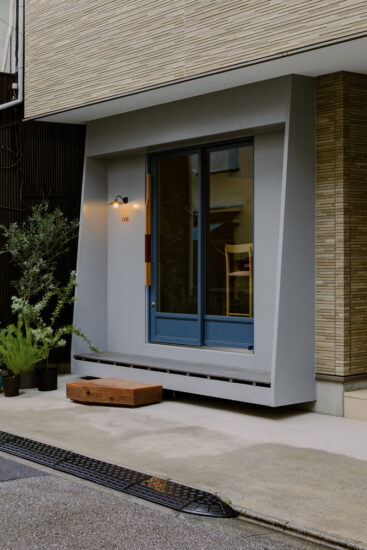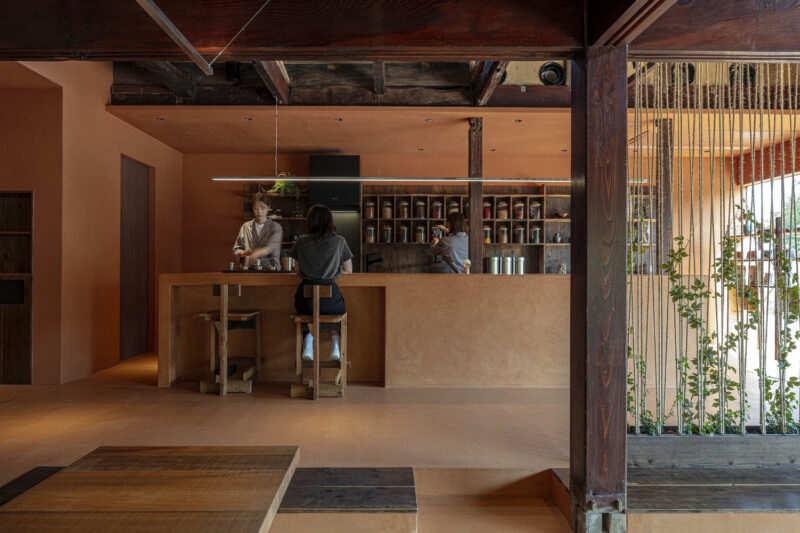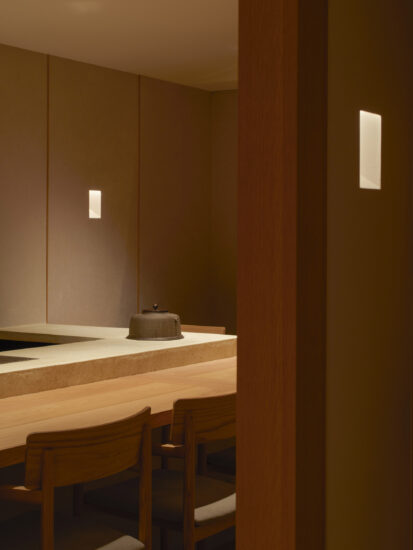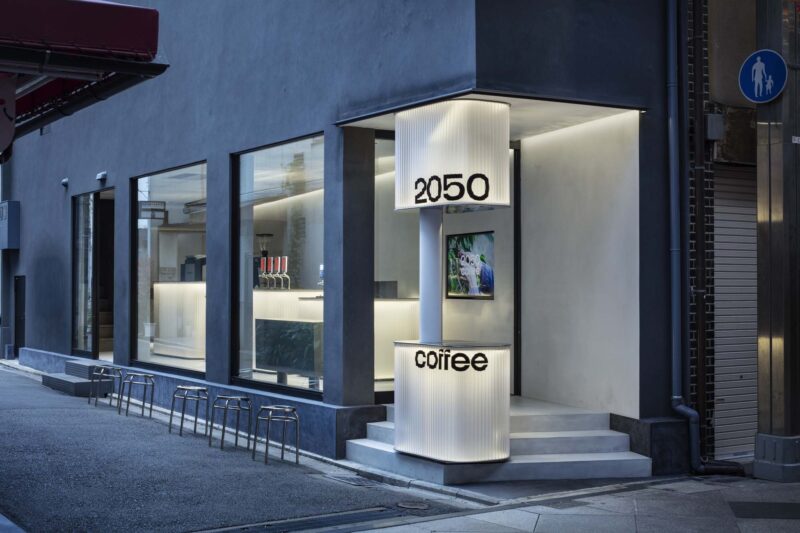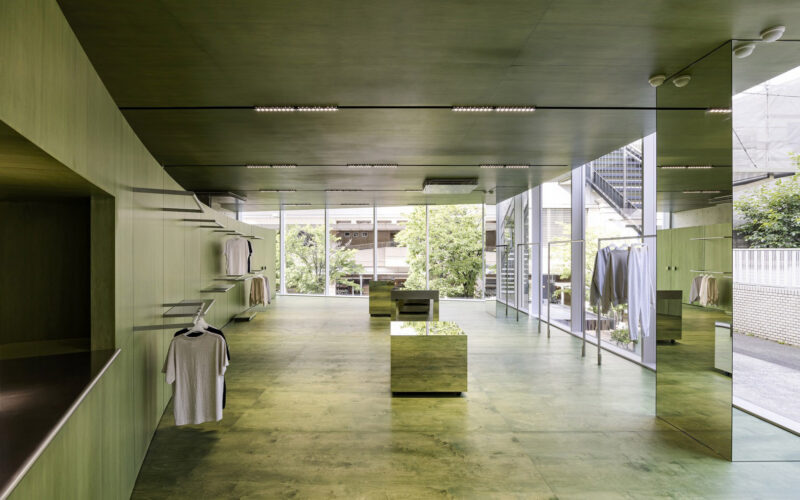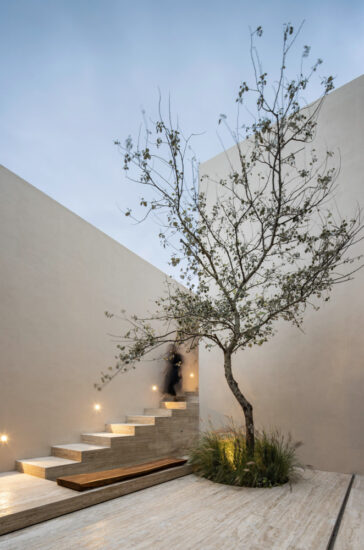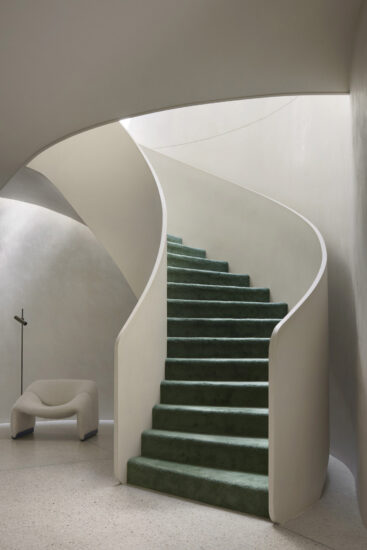该场地位于交通流量大的公路沿线,并围绕着客户运营的混凝土工厂和父母居住的传统日本住宅展开。因为环境给人的印象有点混乱,所以他们想要一所既能产生视觉扩张又能遮挡周围环境的房子。
The site is located along a highway with large volume of traffic. A field expands around the site that is adjacent to the concrete factory run by the client, and a traditional Japanese house where the parents reside. Because the environment gives somewhat mixed-up impression, a house was sought that would produce visual expansion while blocking eyes from surroundings.
因此,我设计了一个住宅,它的轴线与北侧对齐,在那里你可以获得最宽的视野,同时布置了从入口到最后面的露台的空间,它们有自己的延展性。由体量组成的对称立面凹进部分被设计成入口。位于中心的厚重的墙壁增加了更多的深度感,也遮挡了人们的视线。
Thus, I planned a house that aligns its axis with the north side where you can obtain the widest view, while laying out the spaces that have their own extensity from the entrance through the backmost terrace. The recess of the symmetric façade composed of the volumes is made into the entrance. The thick and heavy wall positioned at the center adds more sense of depth. It also plays a role of “Eye Stop” that keeps eyes outside from easily coming through.
当进入大厅时,由高体量创造的空间以来自顶灯的水光欢迎客人。空间被无缝的玻璃侧壁分割开来,给人一种透视效果,让人可以看到远处的空间。两个粗糙纹理的墙壁被提供给特殊的方向和沉重的印象,以及作为通往客厅的通道之间的空间。在通道中,设置了一扇可以灵活开启/关闭的门,形成多样化的空间体验。
When entering the hall, the space created by the tall volumes welcomes guests with watery light from the top light. The space is divided by seamless glass sidewalls, which give a perspective effect to visibility of the space beyond. The two rough-textured walls have been provided to give special direction and weighty impression, as well as to make the space in between as a passage to the living room. In the passage, a door has been positioned that can be flexibly opened/closed to develop diverse space experiences.
相互连接的起居和餐饮空间被包围在一个大空间中。设计师尝试通过区分天花板高度和地板高度来划分空间。同时,从一个精心设计的开口发出的光线产生了变化的阴影和纹理,创造了一个深空间。
The living and dining spaces that are connected with each other are encompassed within a large volume embraced by the space. An attempt has been made to segment the space by differentiating ceiling height and floor level. At the same time, the light from a carefully-planned opening has produced changing shadow and texture, and created a deep space.
在该区域的尽头,设计师想要实现一个包含场景或灯光的开放空间。因此,他布置了一个可以作为客厅延伸的房间,并提供了一个围绕着房间的露台。用于房间的瓷砖也用于露台以产生扩展感,同时增强房间内部和外部之间的连续性。通过北侧的玻璃墙,你可以欣赏到被墙的水平线剪下来的景色,让房子的印象更加丰富。
At the end of the area continued from the entrance, I wanted to realize an open space that incorporates scenes or lights. Therefore, I laid out a room that can be used as an extension of living room, and provided a terrace that surrounds the room. The tiles that are used for the room are also used for the terrace to produce expanding feel while enhancing continuity between inside and outside of the room. Through the glass wall at the north side, you can enjoy the view clipped out by the horizontal line of the wall, making the house impression far richer.
空间序列沿着轴线展开,产生舒适的宁静,给日常生活带来精致的美学。
The sequence of spaces, which are unrolled along the axis, generates comfortable tranquility that gives exquisite aesthetics to daily life.
完整项目信息
项目名称:静寂の家Tranquil House
项目位置:日本滋贺县
项目类型:住宅空间/私人住宅
场地面积:845,69㎡
建筑面积:158,65㎡
完成时间:2019
设计公司:FORM/Kouichi Kimura Architects
主创设计:Kouichi Kimura
摄影:Norihito Yamauchi





















![[4K] 4.14G WABI – SABI侘寂视频](http://www.cipmag.com/wp-content/uploads/2024/08/20240819104405-445x550.jpg)
